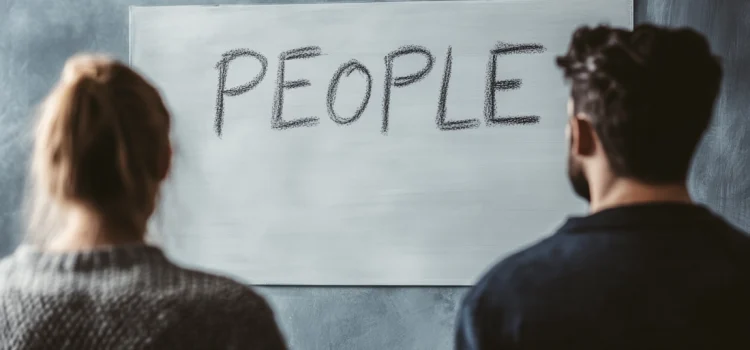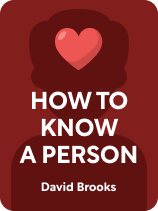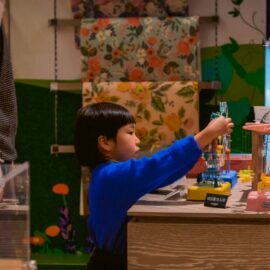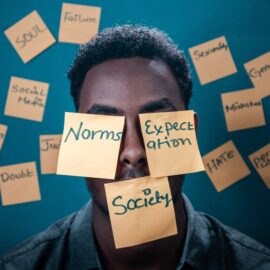

This article is an excerpt from the Shortform book guide to "How to Know a Person" by David Brooks. Shortform has the world's best summaries and analyses of books you should be reading.
Like this article? Sign up for a free trial here.
Do you feel like you don’t know the people around you very well? Do you want to know how to understand people better?
While learning to know other people is crucial, David Brooks acknowledges that it takes a lot of time and effort to cultivate this skill. But he contends that anybody can learn to know others by mastering three skills.
Let’s examine each of these skills in more detail so you can learn how to practice them.
1. Learn to Make People Feel Seen and Valued
Brooks explains that it’s crucial to interact with others in ways that show them you appreciate them and want to understand them. This involves several skills you can practice every day, like being open to what people share with you, learning to be present with others through even the mundane things you do together, and using your conversational skills to deepen your connections with people. Here are recommendations to help you learn how to understand people better.
Open Yourself Up to What People Share With You
To help people feel that you value them for who they are, you first have to make it clear that you want to get to know them. Brooks says you can do this by opening yourself up to others’ ideas, experiences, and perspectives. Make a point of listening closely when they share with you: They’ll realize you’re open to what they’d like to share if you’re generous as a listener when they tell you about themselves.
The goal isn’t just to listen for the sake of it. Instead, it’s to develop a respectful understanding of a person’s contradictions, uncertainty, and struggles. Only by opening yourself up to what people share with you can you witness the dignity with which they handle the challenges they encounter in their life.
Be Present With People Through Everyday Experiences
A second way to show people you see and value them is to be present in the moments you share with them each day, even when you’re doing something routine. Brooks notes that you probably spend most of your time doing the mundane things that make up everyday life: collaborating on projects with your coworkers, cooking dinner with your partner, driving to school with your kids, striking up a conversation with the neighbors, and so on. He recommends learning to see these moments as chances to engage with the people you share them with: to bring your whole self to those moments and to enjoy seeing how others navigate their lives.
Brooks explains that when you do something with another person, like writing code together or looking at the same painting, you’re often side-by-side with them—but you may see things differently from your seemingly similar vantage points. Focusing on something together is an opportunity to see their unique perspective.
Engage and Improve Your Conversational Skills
A third crucial tool for helping others feel understood is simply to engage them in a great conversation. Brooks explains that you can have compelling, enriching conversations even with people you’re still getting to know. That’s especially true if you make a point of cultivating your conversational skills. To turn everyday encounters into a chance to get to know someone better, you have to hone your ability to listen. Brooks explains that we often fail to really listen to one another, but that’s a bad habit you can break with a little bit of work.
Brooks recommends using active listening techniques to engage with what the other person says—and to signal to them that you’re really paying attention. By paraphrasing or summarizing your understanding of what you’re hearing as the other person speaks, you can check in with them and make sure you’re on the same page with them. You can also use nonverbal cues—like maintaining eye contact, leaning in when the other person speaks, and nodding your head—to show them how engaged you are. If they feel confident that you’re really listening, that can help them feel more comfortable sharing their thoughts and their perspective with you.
Even conversations about mundane topics offer you a chance to connect with someone, according to Brooks. If you can make people feel valued when you’re talking about the traffic in your neighborhood or comparing notes on the movie you both saw over the weekend, you’re well on your way to building a meaningful relationship with them.
2. Learn How to Dig Deeper Into People’s Life Stories
Brooks explains that once you’ve begun to cultivate the skills that help you make others feel understood, the next step is to engage fully with the stories that others tell you about who they are, where they’ve been, and where they want to go. In this section, we’ll explore three ways you can do that in your everyday life.
Practice Asking People the Right Questions
Brooks writes that the first step to engaging more deeply in someone’s story is to learn to ask good questions. When you want to discover how someone sees the story of their life, you can’t ask perfunctory questions and expect to get deeply insightful answers in return. For example, Brooks recommends that instead of asking someone what they think about a particular topic, you could ask how they came to think the way they do about that issue.
Brooks contends that, contrary to popular opinion, it’s often OK to ask people big questions: the kinds of questions that we ask as children but get squeamish about posing to each other as adults. He thinks it’s a good idea to ask people questions about what they believe about the world, what kind of person they know themselves to be, and what they value most in their lives. Most people want to tell their story—once you’ve established a trusting relationship with someone, Brooks thinks the chances are good that the other person would welcome a conversation about the big, philosophical questions they rarely get asked.
Brooks recommends that in addition to asking big questions about a person’s philosophy, you can also ask more concrete questions about the things they’ve experienced. For example, as a person tells you about something they’ve done, you can ask detailed questions that help them go deeper into the story and explain what the experience was like for them. Brooks notes that you should always aim to ask questions that invite genuine answers: answers that tell you something about the other person. By asking good questions, you can honor the other person’s ability to make sense of their life, experiences, and beliefs.
Help Others See Their Stories (and Themselves) More Clearly
The second step Brooks recommends for going deeper into people’s stories is to engage with those stories with the goal of helping others to tell better stories about themselves. Brooks contends that even as you ask questions to learn the story of someone’s life from their perspective, you can use your perspective to help them see themselves more clearly. We have a natural tendency to arrange our experiences into neat stories. But sometimes, these stories aren’t entirely accurate. Brooks explains that you can pay attention to the ways in which a person’s story doesn’t fully represent who they are or capture the direction their life seems to be going in. Then, you might be able to help them change that story.
He emphasizes that when you listen to someone else’s story, you can simultaneously fully accept and respect them as a person and also help them make their story more honest. In doing so, you help them to see the best in themself and the person they’re becoming. For example, you might have a friend who consistently portrays themselves as always moving forward and never encountering setbacks. You can acknowledge their achievements but also gently point out that the challenges they’ve faced have made them more resilient as a person. By encouraging your friend to include these more difficult episodes in the story they tell, you can help them build a more authentic and balanced view of who they are.
Recognize the Influence of a Person’s Culture and History
Brooks’s third step to engaging more deeply with people’s stories is to look for the influence of their culture and personal history on the events and choices they’re telling you about. Brooks says some of the key events in a person’s story began long before they were born: in the history of the place they grew up or in the backstory of the people they’re descended from. He believes our ancestors’ history lives on in all of us. So, to really know a person, it helps to learn where they came from and how it impacted their view of the world and their place in it.
Brooks explains that you can simply ask a person how their life has been shaped by their ancestors or by the culture of the place where they grew up. Often, people have ideas about how these influences have shaped their life, their character, and the way they relate to others. But as we discussed earlier in the guide, relying on stereotypes is counterproductive. (That’s why it’s crucial to learn about how a person’s background has impacted them by simply asking them.) Brooks also notes that it’s often wise to get an idea of how closely they identify with or separate themselves from their culture. Not everybody has the same relationship with the people and places they come from, and while the social groups we’re part of provide important context, we can’t be reduced to them.
3. Practice Difficult Social and Emotional Skills
Finally, once you’ve started building your skills in making people feel seen and engaging more deeply with the stories they tell, you can turn your attention to cultivating some social skills that don’t come naturally to many people. Brooks explains that as we practice learning to know others, we often have to work to counter some of our natural tendencies: the tendency to see things in a self-centered way, to be impatient rather than empathetic, or to shy away from the messy parts of others’ lives. Next, we’ll take a look at how you can work on these tendencies.
Learn to Center Others, Not Yourself
We’re all at the center of our own worlds, and we naturally center ourselves in our thoughts and our conversations. Brooks explains that by stepping back from your ego and how it wants you to see the world, you can make more room for other people. A great place to start is in the conversations you have every day with others. We all love talking about ourselves, and we sometimes find it challenging to talk about someone else for a change. By learning to resist the tendency to turn the conversation back to yourself—like by telling a friend who’s having trouble with a colleague about your own struggles at work—you can do a better job of being present with them.
Another way Brooks recommends exercising care for others is to pay attention to social situations and to make them more comfortable and equitable for everyone. If there’s a major difference between you and another person—whether in political views or in the amount of power or access you have in a given context—it’s easy for you to make them feel misunderstood or excluded. Brooks advises working to put everyone on even footing so you can exchange ideas respectfully and authentically. For example, you might go into a meeting at work with more seniority than others in the room. But if you take the time to discuss everyone’s opinions, you’ll put your junior colleagues at ease and help them feel their voices are heard.
Practice Empathy
Just as we tend to center ourselves, we can also naturally be impatient with people and jump to conclusions about how they’re handling a conversation or a situation. But Brooks explains that by practicing the skill of empathy, you can set yourself up to better understand others. He explains that empathy involves three skills: mirroring, mentalizing, and caring. Mirroring and mentalizing involve understanding the emotions that someone else is feeling in their current circumstances, either by experiencing those emotions yourself or by remembering what you felt in a similar situation. Caring involves centering the other person’s needs—which will often be different from what you would want or need if you were in a similar situation.
Practicing empathy can help you support people in particularly difficult situations where many of us wouldn’t know what to say or what to do, such as when someone undergoes a loss, a mental health crisis, or another difficult period of their life. Brooks acknowledges it’s hard to know how to support someone in these moments. But you can do so by being present with them in their reality as they see it instead of trying to talk them into seeing things a different way.
See People Clearly in Their Current Stage of Life
Finally, Brooks explains that it’s important to learn to see where people are in their life. To understand how each person is moving through their personal challenges and circumstances, it’s useful to think about where their focus lies. For example, some people are in the process of building an identity and cultivating a unique set of skills. Others are focused on finding important social connections, whether a partner or a close group of friends. Still others are working on building their career or finding a way to make the world a better place.
Brooks explains that learning to recognize these stages can not only help you support others through periods of transition—which are demanding and challenging—but can also help you understand a basic truth about life: that we often have to change and grow to move forward.

———End of Preview———
Like what you just read? Read the rest of the world's best book summary and analysis of David Brooks's "How to Know a Person" at Shortform.
Here's what you'll find in our full How to Know a Person summary:
- The benefits of really getting to know other people
- How to better understand people on a personal level
- Why our morality and relationships are in a crisis






